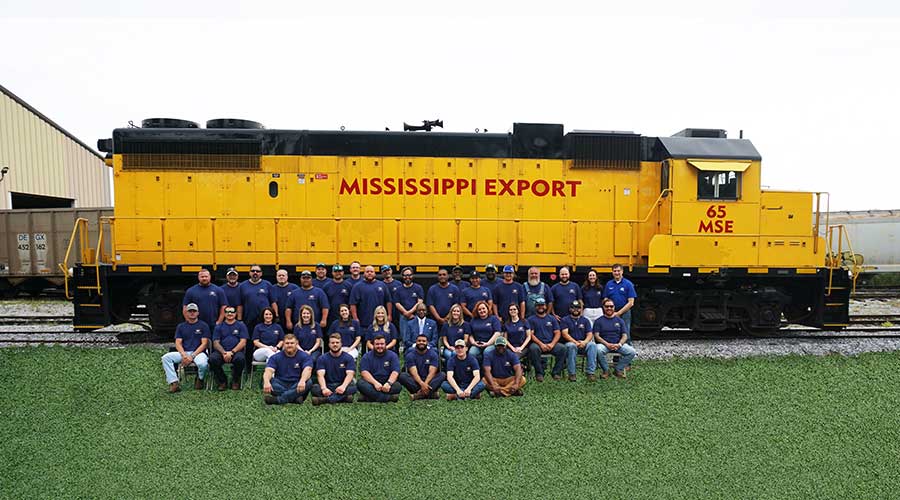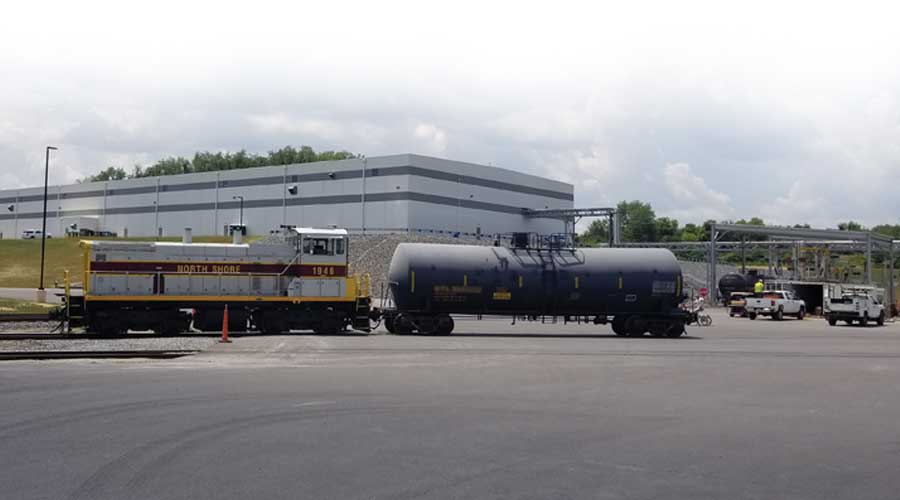Stay updated on news, articles and information for the rail industry
September 2011
Rail News: Short Lines & Regionals
Profile: Alaska Railroad President and CEO Chris Aadnesen
by Desiree J. Hanford
Managing the Alaska Railroad Corp. (ARRC) is a unique opportunity for Christopher Aadnesen, which is fitting because the railroad is unlike any other in North America.
Since September 2010, Aadnesen, 62, has served as president and chief executive officer of ARRC, which provides freight- and passenger-rail services in a state known for its frigid winters and vast wilderness areas. The more than 500-mile regional is owned by the state of Alaska, but is incorporated and operates as a private business. ARRC generates revenue through real estate holdings, year-round passenger services and freight services from Seward to Fairbanks-North Pole.
Aadnesen assumed the regional's top post after logging more than three decades in the rail industry — a career that's taken him from the United States to Mexico to Estonia and back, and evolved from assistant general manager at Union Pacific Railroad to rail consulting firm founder to Texas Mexican Railway executive to Mexican railroad privatization pursuer to head of the Estonian Railways.
A one-time U.S. Navy officer trainee, Aadnesen has strived to develop financial expertise and keen rail operations knowledge throughout his career. His quest has resulted in the accumulation of experience in various realms, including rail transportation, logistics and management; strategic and business planning; and quality systems development.
In Alaska, he's putting most of those skills to the test at a medium-size railroad in a large railroad-like fashion.
"The president/CEO position is a sort of microcosm of everything a Class I railroad's [position] is, but in a smaller, more hands-on package," Aadnesen says. "It is a perfect fit given the broad railroad experience I have enjoyed over the past 38 years."
Aadnesen has acquired a lifetime's worth of experience in running railroads, which is an important attribute, says Ab Rees, a retired railroad executive and former Kansas City Southern senior vice president of operations who's known Aadnesen since the early 1980s. At the time, Rees was part of the senior management team at Missouri Pacific Railroad when it was acquired by Aadnesen's employer, the Western Pacific Railroad.
"He has the proven ability to manage a railroad efficiently and modernize it," says Rees. "He's spent years working in other countries, and dealing with politicians and government entities."
The 'How' In Know-How
Now, Aadnesen is trying to apply his diverse experiences and know-how at ARRC. He's already made some progress during the past year. He has taken steps to improve the railroad's finances, such as by diversifying the railroad's freight revenue base to make it less reliant on a small number of customers.
A few years ago, hauling petroleum products from a refinery outside of Fairbanks accounted for about half of ARRC's revenue; now, it accounts for about 30 percent, with other revenue mainly generated from a barge service and coal movements.
The safety of employees, local communities and trains also are paramount to Aadnesen. So, the railroad continues to employ an ongoing safety program designed to reduce accidents and incidents.
In addition, he's working to improve the relationship between the railroad and five unions that represent ARRC workers.
"We will employ an approach that involves listening and learning, recognizing both sides have requirements, educating stakeholders and treating employees fairly," Aadnesen says, adding that he expects bargaining to be "rigorous."
His team-oriented, light-hearted approach to working with people and employees, from the rank and file to top management, sets Aadnesen apart from other rail industry executives, Rees believes.
"Some people are cold and hard-driving and make life difficult for subordinates, but [Aadnesen] has a sense of humor and the ability to make people happy when they're working as hard as they can," he says. "That sense of humor and ability to make hard work enjoyable is how he builds management teams that are so loyal."
Cut From A Different Cloth
Aadnesen admits he doesn't have the traditional makeup of a senior railroad officer.
"I'm more of a collegial type of person who engages in teamwork instead of the hierarchical approach," he says.
Aadnesen began to mold his approach back in his schooling days in the late 1960s, when he never imagined he'd pursue a rail industry career because his family ran a wine distribution business that at one time seemed to be a future calling. However, Aadnesen also came from a military family and the U.S. Navy Reserve Officers Training Corps (ROTC) offered to pay all his college expenses. So, he opted to pursue a congressional appointment to the Navy ROTC program and obtained one at Brown University. He participated in the program from 1967 to 1969, but left after he injured a knee and no longer qualified for the Navy.
A Salt Lake City native, Aadnesen then decided to transfer to the University of Utah, where he graduated with a bachelor's degree in English in 1971, then earned a master of business administration degree two years later. Years later, he completed executive management programs at the University of Pittsburgh and Harvard University.
Aadnesen paid for his undergraduate education by playing lead guitar — a 1961 Fender Jazzmaster that he still uses — in rock bands The Whigs and Death Valley Mining Company. The Whigs released two 45-rpm records in 1965 and 1966.
By the time Aadnesen began job hunting after earning his master's degree, the only company still conducting interviews on the Utah campus was Western Pacific Railroad. In 1973, he joined the railroad — which became part of Union Pacific Railroad in 1982 — and began his rail career.
Through hard work and some success in various roles, including assistant general manager, he was rewarded with several promotions, says Aadnesen. Eventually, he worked with nearly all departments involved with railroad management.
Mexican Connection
Aadnesen left UP in 1995 ("It was time to venture out on my own," he says), and one year later founded a consulting firm, Capital City Management Associates, specializing in rail transportation and financial planning. Working with Kansas City Southern and Grupo TMM S.A. de C.V., the firm competed to purchase and privatize one of three lines owned by the Mexican government through its Ferrocarriles Nacionales de Mexico, or National Railways. A railroad that eventually became TFM S.A. de C.V., and now is known as Kansas City Southern de México S.A. de C.V., was formed to operate the line.
The three partners bought the line from the Mexican government for $1.4 billion through a transaction largely financed with the sale of bonds. Aadnesen, who became chief operating officer and executive vice president at TFM after the acquisition, sold bonds to investors on the East Coast and in Europe. He eventually earned a reputation in finance markets as someone with financial savvy and extensive railroad knowledge, says Aadnesen.
He faced several challenges at TFM, including how to make the railroad more efficient, says Rees, who again crossed paths with Aadnesen at TFM. While government owned, the railroad had lost money for several decades. In addition, the railroad's information technology was outdated and it employed more train crew members than necessary, Aadnesen says.
He tried to address those issues and overcome other hurdles while navigating a language he didn't speak and dealing with a culture he wasn't accustomed to, Aadnesen says. His team developed action plans for each area of improvement and hired best-practice experts from other North American railroads to manage the implementation of those improvements, as well as trained managers to become future leaders at the Mexican railroad.
No matter the setting, Aadnesen has shown the ability to build management teams that work cohesively and are loyal to him, says Rees.
"He's always had that ability. He had it in Mexico and the U.S.," says Rees. "I suspect it's the same in Alaska."
Enter Estonia
Aadnesen retired after leaving TFM in 2000, but he later decided to join consulting firm HNTB Corp. in 2003 as a part-time consultant and railroad expert on the Trans-Texas Corridors project. Six months later, he was recruited to become chairman and CEO of the Estonian Railways.
The railroad had been privatized in 2001, with an international investor consortium owning 80 percent and the Estonian government, 20 percent. Aadnesen was hired when the private investors wanted someone to oversee the sale of their half ownership in the Scandinavian and European financial markets.
But shortly after he arrived in Estonia, a newly elected government sought to renationalize the railroad. The government planned to charge Russian train operators access fees that were too low to properly compensate Estonian Railways for operating on its lines, Aadnesen says. The government's goal: force the railroad to be sold to the government at a deeply discounted price, he says.
A combination of factors, including negotiations, international litigation and diplomatic pressure, led the government to purchase the railroad "at a fair price" in 2007, Aadnesen says. He left the railroad that year and returned to HNTB, which had continued to recruit him to return to the firm during his three years in Estonia. He led HNTB's national freight-rail services for all seven Class Is until he joined ARRC in 2010.
Aadnesen retains a three-year contract with ARRC that expires in September 2013. Although he believes it's too early in his tenure to take credit for any recent accomplishments, Aadnesen hopes to be viewed as someone who works well with others on the "nuts and bolts" of running a successful railroad and helps solve long-standing issues, he says. Like other companies, ARRC has gotten into the habit of "kicking problems down the road," but he'd rather solve them as they arise, Aadnesen says.
To do so, you first need to listen and understand a problem, and then determine whether to fix it immediately or assemble a team and process to correct it, depending on the problem's complexity, he says.
A Listener And Team Builder
Because of Aadnesen's listening, team-building and follow-through skills, as well as his honesty and integrity, Rees has high expectations for him at ARRC.
"My hope is that maybe 10 or 20 years from now, we'll see that he positioned the company to be extremely innovative, successful and profitable, and that it made the people of Alaska very happy with his leadership," says Rees.
Aadnesen acknowledges that railroad management is demanding and difficult. But at this point in his career and at his age, "there is probably little else I could do, except possibly join a retro rock-and-roll band," he jokes. Yet, there are always more hurdles to clear and teams to build for an astute railroad leader who's long welcomed a demanding post.
"The success I have had ... has kept me in the business," says Aadnesen. "The challenge and 'fun of the hunt,' so to speak, makes railroading attractive to me."
— Desiree J. Hanford is a Chicago-based free-lance writer. Email comments or questions to prograil@tradepress.com.
Keywords
Browse articles on Chris Aadnesen Christopher Aadnesen Alaska RailroadContact Progressive Railroading editorial staff.


 2025 MOW Spending Report: Passenger-rail programs
2025 MOW Spending Report: Passenger-rail programs
 Gardner steps down as Amtrak CEO
Gardner steps down as Amtrak CEO
 Guest comment: Oliver Wyman’s David Hunt
Guest comment: Oliver Wyman’s David Hunt
 Women of Influence in Rail eBook
Women of Influence in Rail eBook
 railPrime
railPrime







